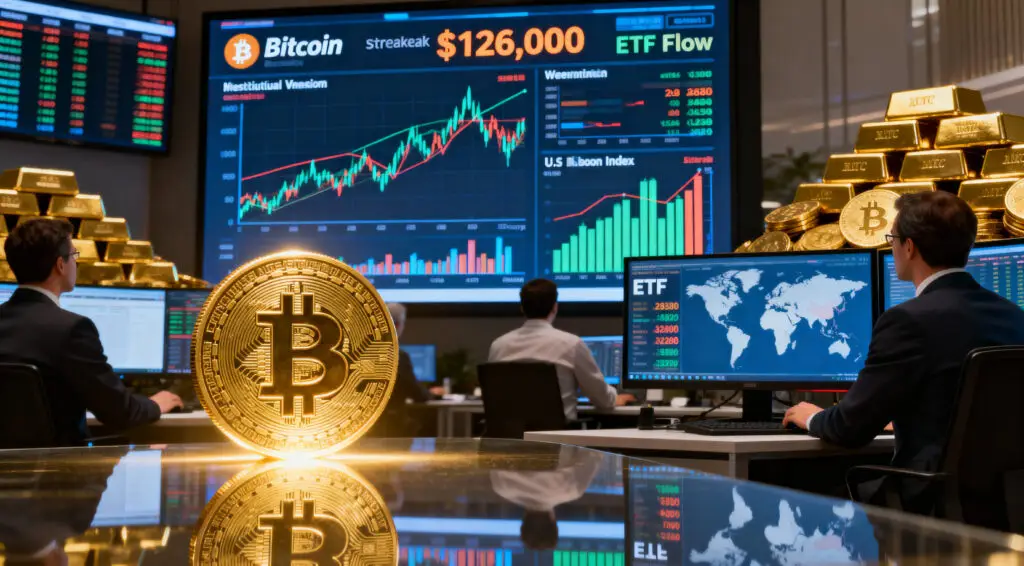Bitcoin Breaks Records Amid ETF-Fueled Rally
Bitcoin reached a new all-time high of $126,080 on October 6, driven by massive inflows into spot-based exchange-traded funds. Investors poured $1.2 billion into BTC ETFs that day alone, marking the second-largest daily inflow ever recorded. Despite a slight pullback to $122,000, sentiment remains overwhelmingly bullish as institutional demand continues to grow. Analysts attribute this rally not to corporate treasury buys, but to surging ETF participation from global investors.
BlackRock’s IBIT Leads the Institutional Charge
BlackRock’s IBIT ETF dominated the inflow wave, claiming $970 million of the total. The fund now manages nearly $100 billion in assets and holds over 791,000 BTC, up from 661,000 in June. Bloomberg’s Eric Balchunas noted that IBIT could soon become the fastest ETF to surpass $100 billion in history. The success of IBIT signals that institutional players are viewing Bitcoin not merely as speculation but as a core digital asset class.
Crypto ETFs Expand to Ethereum and Solana Staking
Grayscale followed up the ETF frenzy by launching the first U.S.-listed Ethereum staking ETFs, allowing investors to earn passive yields on ETH. The Grayscale Ethereum Trust and Ethereum Mini Trust staked 32,000 ETH—worth about $150 million—through institutional validators. Solana-focused ETFs in Europe and Asia have seen similar growth, showing how staking products are reshaping institutional crypto exposure.
Dollar Decline Fuels Demand for Hard Assets
The U.S. dollar has dropped 10% since January, on pace for its worst performance in forty years. Economic uncertainty, tariff policies, and mounting federal debt have shaken investor confidence. As a result, both Bitcoin and gold are benefiting from the flight to safety. Gold futures hit $4,000 per ounce on October 7, with prices up 50% this year. Analysts now describe the market as a “de-dollarization phase,” where investors are seeking alternatives to U.S. sovereign assets.
Central Banks and Investors Diversify Away From Treasuries
Foreign governments have reduced their reliance on U.S. Treasury holdings, pushing the dollar’s share of global reserves to 56.3%, its lowest in three decades. Citadel CEO Ken Griffin warned that global asset inflation is accelerating as investors “de-risk” from the dollar.
Stablecoin issuers, meanwhile, are offsetting some of the pressure by purchasing Treasury bills as collateral for their dollar-backed tokens—helping sustain demand for U.S. debt instruments despite capital outflows.
Recommended Article: Bitcoin Hits $126K as Institutional Inflows Break Records Amid Debasement Fears
Stablecoins and Tokenization Enter the Spotlight
World Liberty Financial, founded by Eric and Donald Trump Jr., has positioned its USD1 stablecoin as a defender of dollar dominance. With a $2.6 billion market cap backed by Treasury investments, USD1 aims to encourage global dollar adoption through blockchain-based tokenization.
WLF CEO Zack Witkoff revealed plans to tokenize real-world assets—including oil, timber, and real estate—anchored to USD1 as the trading base. This approach aligns with a growing trend of merging DeFi innovation with traditional asset management.
Financial Giants Deepen Blockchain Integration
Traditional institutions are expanding into tokenized finance. Coinbase has applied for a federal trust charter, joining Ripple, Circle, and Paxos in seeking national licensing for crypto custody and payments. Meanwhile, BNY Mellon is exploring blockchain-based deposits to streamline global payments, and the NYSE’s parent company invested $2 billion in prediction-market platform Polymarket. These developments signal that traditional finance and crypto are converging faster than regulators can adapt.
Market Outlook: Digital Assets at a Crossroads
With Bitcoin and gold reaching record highs, and the U.S. dollar under pressure, markets are redefining what constitutes a safe haven. ETF inflows have legitimized Bitcoin’s institutional role, while tokenization and stablecoin projects are rewriting monetary dynamics. As the Federal government remains gridlocked and global de-dollarization accelerates, digital assets may continue to rise as both a hedge and a new financial frontier for global investors.























